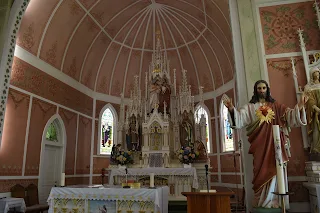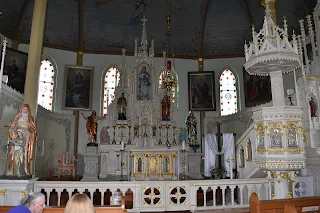Everywhere people had established a community we find small pockets of history. It is the collection of all these micro stories that make up the entire history of a nation. No matter how small or large a state in these United States, its people and its culture are a collective patchwork of many. Texas is no exception. Fredericksburg - you've read about two musings ago. A much smaller patch has a similar but different story to tell.
About 95 miles from Houston is Schulenburg, Texas, part of Fayette County. It is a small city of under 3000 people in slightly over 1,000 households, tiny by any measure of population standards, and tinier still, geographically speaking - under 3 square miles (6.5 sq. km) of land. Within this area had stood Four Painted Churches. That they still stand there today is testament to a group of people whose story goes back to the mid-1800's; and further back in time if we were to look at where they came from.
Tourists or tour groups who come to visit are under no illusion that they are visiting the grand cathedrals in Europe. These are not super structures built by kings and emperors but they should loom large because what physical grandeur they lack can easily be ignored if we focus on the courageous and noble stories behind the stories of how the churches came to be and the people who built them.
The churches stand for much more than a particular religion but rather as a collective symbol of every struggle known to man, the triumph of the spirit and unbridled determination to survive and prevail over unimaginable adversity. The U.S. is what it is today because of the many number of these kind of struggles that make up its whole history. Lest we forget there was a time when people came not by large steam ships or later by jumbo jets or by border crossings today that is dividing the country. There was a time when the bell toll of freedom and opportunity were heard from half way across the world in another continent by a band of people willing to take a chance at the unknown. Schulenburg has such a story. The painted churches and the cemeteries that adjoin each one of them are testimony to generations of families driven by courage, skills and the indomitable human spirit.
Their story began with the collapse of the Austria-Hungary empire after the First World War. Prior to that, for centuries, tribal factions comprised of Celtic, Czech, Slavic, Germanic and Slavic ancestry, doubtless all genetically related. But human conflict was, as always, a prevailing theme that divided people. In the middle of the 19th century the economic and political conditions became unbearable for many. A band of families from two primary regions that were Moravia and Bohemia, predominantly Czechs, boarded a hundred foot ship towards a place they heard was the new promised land. They were on that ship for thirteen weeks. Imagine sailing for that long. Sleeping accommodations were the least of their problems since food, water, sweltering heat during the day and cold winds and rough seas at night probably kept them from thinking about sleep.
Their port of entry was Houston, TX. The year was 1856. Sick, tired, hungry and weak with little money and not speaking the language, their situations were dire, to say the least. But they somehow managed to put together provisions into horse drawn wagons to complete their journey to a patch of land almost a hundred miles away. At that point a hundred miles must have felt like a few steps compared to where they came from but it still took them a whole month to reach it. Today, Schulenburg is about an hour and a half from Houston by car.
One group of several families found a land teeming with giant oak trees, a river and grass land. The prospect of a climate warmer than the winters of Europe was shattered almost immediately by an unexpected winter storm. The families huddled under the canopy of oak trees where they built fires to keep warm. As Texas winters go the weather came and went like ocean squalls they had gotten used to in the thirteen weeks they were at sea. They then built little huts that later turned into permanent homes, using timber from the plentiful oak trees. This is important to make note of because in one of the painted churches oak leaves, acorn and oak tree branches were dominant themes. Even the shoulder ends of the church pews were shaped like half an oak leaf.
They worked hard. They helped each other and they prayed together. They believed that it was their faith in providence that guided them through and nothing was more unifying than a place of worship. They were grateful for the new land but they were not about to forget or relinquish the memories of their homeland. Most were of Czech and Austrian descent so their culture was a cross between the two. There is much evidence of that culture in the form of polka music and dance, kolaches (Czech pastry) among many. The painted churches no doubt stand today to remind us that these people relied and believed in the divine intervention of their survival.
The building of the churches was proof of their resourcefulness and their skills and that of their pragmatism. They were determined to build them but they were not about to splurge or recklessly spend money just for the sake of grandeur. The structures were going to be places of worship that reminded them of the old homeland but they were going to be austere, yet pleasing to the eyes of the God they worshiped. They skillfully painted the interior of the churches. The paintings had themes that portrayed their culture and symbols of their experiences. These early immigrants, like all the others who came during that era, were not only resourceful and determined, they were skillful craftsmen, artists and scholars.
The Painted Churches are more than just symbols of their faith. They used paint to make wooden columns look like marble, flat surfaces to stand out as three-dimensional pieces, stained glass and statues can be museum pieces. Today these churches still conduct regular services but funds for the costly maintenance come from donations and proceeds from group tours since the local congregation, still small as it had always been, cannot provide adequate financial support. Even from their early beginnings the churches never received funds from the bigger national church chapters, least of all from the Vatican or international organizations.
One does not have to be affiliated with a particular faith or religion to appreciate what these four churches stand for. The narrative they tell may represent little significance to the larger history of the country but we should not forget that it is the little stories that are closest to our understanding of those who lived before us. Years ago I met someone who told me she was of Czech descent. I assumed then that she was a child of a first generation immigrant. I was surprised when she told me her ancestry went way back to an earlier era in Texas history. I didn't pay much attention then but now I understand.
The photos tell the story a little better. One church was rebuilt after it burned down. There had been renovations but much of the interior paintings were preserved as they were originally. Some captions add a handful of footnotes.
 |
| Each church had a cemetery nearby. Imagine the number of generations that were added to the citizenship of the country and their contributions to the nation as a whole. |
 |
| The stained glass were such that allowed for sufficient outside light |
 |
| Note the Czech writings on this "Station of the Cross" |
 |
| Those metal clips at the back of the pews used to hold the hats of the male congregants. The early churches had men seating on the right side, so the left pews where the women sat did not have these clips (The clips today remain but they are obviously not for holding hats anymore). |
 |
| The columns and arches are all wood |
The two photos below show how the paints were skillfully done to make wood look like marble. One had to knock on the columns to realize they're wood.
 |
| Acorns and oak leaves were part of the theme in this church. |
 |
| Our guide explained how in this church the male statues were on the right while the left had the female images. The placement indeed dictated where the men and boys sat separated from the women and the girls who sat on the left. I did not know this before then but our guide explained why in weddings the groom's side sat on the right and the bride's side sat on the other. Who knew? |
 |
| The end of the pew in one church had half of an oak leaf as a theme |
 |
| Note again the recurrent theme of oak leaves and acorn on the stained glass. |
Visit the Chamber of Commerce for more information. Check out the Stanzel Model Aircraft Museum. In 1925 Victor Stanzel started building model airplanes that he sold nation wide. A converted spare bedroom in their Schulenburg farmhouse started a model aircraft manufacturing business that later became wired and remotely controlled model aircraft.




























No comments:
Post a Comment